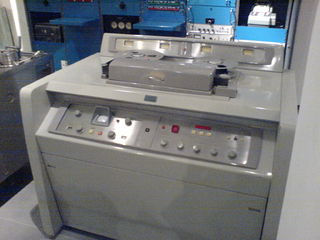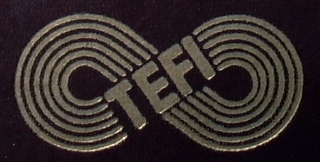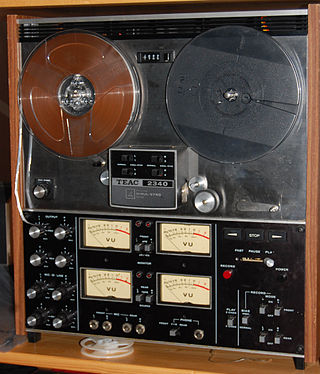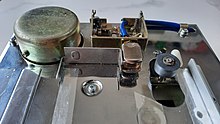
Magnetic tape is a medium for magnetic storage made of a thin, magnetizable coating on a long, narrow strip of plastic film. It was developed in Germany in 1928, based on the earlier magnetic wire recording from Denmark. Devices that use magnetic tape could with relative ease record and playback audio, visual, and binary computer data.

The Compact Cassette, also commonly called a cassette tape, audio cassette, or simply tape or cassette, is an analog magnetic tape recording format for audio recording and playback. Invented by Lou Ottens and his team at the Dutch company Philips in 1963, Compact Cassettes come in two forms, either containing content as a prerecorded cassette (Musicassette), or as a fully recordable "blank" cassette. Both forms have two sides and are reversible by the user. Although other tape cassette formats have also existed—for example the Microcassette—the generic term cassette tape is normally used to refer to the Compact Cassette because of its ubiquity.

An audio tape recorder, also known as a tape deck, tape player or tape machine or simply a tape recorder, is a sound recording and reproduction device that records and plays back sounds usually using magnetic tape for storage. In its present-day form, it records a fluctuating signal by moving the tape across a tape head that polarizes the magnetic domains in the tape in proportion to the audio signal. Tape-recording devices include the reel-to-reel tape deck and the cassette deck, which uses a cassette for storage.

The 8-track tape is a magnetic-tape sound recording technology that was popular from the mid-1960s to the early 1980s, when the compact cassette, which pre-dated the 8-track system, surpassed it in popularity for pre-recorded music.
A cassette deck is a type of tape machine for playing and recording audio cassettes that does not have a built-in power amplifier or speakers, and serves primarily as a transport. It can be a part of an automotive entertainment system, a part of a portable mini system or a part of a home component system. In the latter case it is also called a component cassette deck or just a component deck.

Reel-to-reel audio tape recording, also called open-reel recording, is magnetic tape audio recording in which the recording tape is spooled between reels. To prepare for use, the supply reel containing the tape is placed on a spindle or hub. The end of the tape is manually pulled from the reel, threaded through mechanical guides and over a tape head assembly, and attached by friction to the hub of the second, initially empty takeup reel. Reel-to-reel systems use tape that is 1⁄4, 1⁄2, 1, or 2 inches wide, which normally moves at 3+3⁄4, 7+1⁄2, 15 or 30 inches per second. Domestic consumer machines almost always used 1⁄4 inch (6.35 mm) or narrower tape and many offered slower speeds such as 1+7⁄8 inches per second (4.762 cm/s). All standard tape speeds are derived as a binary submultiple of 30 inches per second.

A video tape recorder (VTR) is a tape recorder designed to record and playback video and audio material from magnetic tape. The early VTRs were open-reel devices that record on individual reels of 2-inch-wide (5.08 cm) tape. They were used in television studios, serving as a replacement for motion picture film stock and making recording for television applications cheaper and quicker. Beginning in 1963, videotape machines made instant replay during televised sporting events possible. Improved formats, in which the tape was contained inside a videocassette, were introduced around 1969; the machines which play them are called videocassette recorders.

Earl William "Madman" Muntz was an American businessman and engineer who sold and promoted cars and consumer electronics in the United States from the 1930s until his death in 1987. He was a pioneer in television commercials with his oddball "Madman" persona; an alter ego who generated publicity with his unusual costumes, stunts, and outrageous claims. Muntz also pioneered car stereos by creating the Muntz Stereo-Pak, better known as the 4-track cartridge, a predecessor to the 8-track cartridge developed by Lear Industries.

William Powell Lear was an American inventor and businessman. He is best known for founding Learjet, a manufacturer of business jets. He also invented the battery eliminator for the B battery, and developed the car radio and the 8-track cartridge, an audio tape system. Throughout his career of 46 years, Lear received over 140 patents.
Broadcast automation incorporates the use of broadcast programming technology to automate broadcasting operations. Used either at a broadcast network, radio station or a television station, it can run a facility in the absence of a human operator. They can also run in a live assist mode when there are on-air personnel present at the master control, television studio or control room.

PlayTape is a 1⁄8 inch (3.2 mm) audiotape format and mono or stereo playback system introduced in 1966 by Frank Stanton. It is a two-track system, and was launched to compete with existing 4-track cartridge technology. The cartridges play anywhere from eight to 24 minutes, and are continuous. Because of its portability, PlayTape was an almost instant success, and over 3,000 artists had published in this format by 1968. White cases usually meant about eight songs were on the tape.
Since the widespread adoption of reel-to-reel audio tape recording in the 1950s, audio tapes and tape cassettes have been available in many formats. This article describes the length, tape thickness and playing times of some of the most common ones.

The Fidelipac, commonly known as a "NAB cartridge" or simply "cart", is a magnetic tape sound recording format, used for radio broadcasting for playback of material over the air such as radio commercials, jingles, station identifications, and music, and for indoor background music. Fidelipac is the official name of this industry standard audio tape cartridge. It was developed in 1954 by inventor George Eash, and commercially introduced in 1959 by Collins Radio Co. at the 1959 NAB Convention. The cartridge was often used at radio stations until the late 1990s, when such formats as MiniDisc and computerized broadcast automation predominated.

The RCA tape cartridge is a magnetic tape audio format that was designed to offer stereo quarter-inch reel-to-reel tape recording quality in a convenient format for the consumer market. It was introduced in 1958, following four years of development. This timing coincided with the launch of the stereophonic phonograph record. It was introduced to the market by RCA in 1958.

A videocassette recorder (VCR) or video recorder is an electromechanical device that records analog audio and analog video from broadcast television or other source on a removable, magnetic tape videocassette, and can play back the recording. Use of a VCR to record a television program to play back at a more convenient time is commonly referred to as timeshifting. VCRs can also play back prerecorded tapes. In the 1980s and 1990s, prerecorded videotapes were widely available for purchase and rental, and blank tapes were sold to make recordings.

The Tefifon is an audio playback format, developed and manufactured in Germany, that utilizes cartridges loaded with an endlessly looped reel of plastic tape. It is somewhat similar to the later 4-track and 8-track magnetic audio tape cartridges, but with grooves embossed on the tape, like a phonograph record. The grooves were embossed in a helical fashion across the width of the tape, in a manner similar to Dictaphone's Dictabelt format. The grooves are read with a stylus and amplified pickup in the player's transport. A Tefifon cartridge, known as a "Tefi", can hold up to four hours of music; therefore, most releases for the format are usually compilations of popular hits or dance music, operas, and operettas. Tefifon players were not sold by television and radio dealers in Germany, but rather sold directly by special sales outlets affiliated with Tefi.

Quadraphonic open reel tape or Q4 was the first consumer format for quadraphonic sound recording and playback. Pre-recorded tapes in this format were introduced in the United States by the Vanguard Recording Society in June 1969. Specialized machines to play these tapes were introduced by electronics manufacturers such as TEAC Corporation at about the same time.
Bernard August Cousino was an American music technology inventor. He is known for inventing an endless loop tape cartridge design in 1952, known as the Audio Vendor, patented under US2804401A. The tape is pulled from the inside of a loose tape roll making it spin to wind the returning tape onto the roll again. Initially, this mechanism was mounted on a reel to reel tape recorder. Later Cousino developed a plastic housing to be hung up on some tape recorders. First, the magnetic coating was wound to the inside of the reel. This cartridge was marketed by John Herbert Orr as the Orrtronic Tapette. Newer cartridges had magnetic coating wind of the tape outside the reel, which required a special recorder to operate it, but offers comfortable simple inserting the cartridge without threading the tape. This more compact cartridges do not require any bottom spare for the tape head assembly. That would inspire George Eash to make the Fidelipac tape cartridge, which itself would inspire the Stereo-Pak tape cartridge.
George H. Eash was an American inventor of several magnetic tape audio cartridges having a single tape reel. In 1950s he worked next desk to Bernard Cousino, who invented the endless tape loop, using it at first on an open reel. Eash created further cartridges using this tape loop like the Fidelipac, also known as "NAB-Cartridge" or even "cart" and used in broadcast, and as a consultant of Earl "Madman" Muntz the 4-Track cartridge, known as the Muntz Stereo-Pak or CARtridge. With the Lear 8-Track cartridge Eash's patent plea failed.
An endless tape cartridge is a tape cartridge or cassette that contains magnetic audio tape that can be played in an endless loop, without the need to rewind to repeat.















